It is June 1945, the world is still at war in the Pacific and my father, Seaman First Class, John Thomas Ryan is still serving on the USS Hornet (CV-12). In my last posts, I continued the Battle of Okinawa and covered May 1945. The war ended in Europe but the war with Japan still rages on. In this post, the battle continues with June 1945.
Note: Much of the story of the Battle of Okinawa is a story of the land battle and the US Army and Marines. Since my writing is about the USS Hornet, I only cover the story as it relates to the carrier. The rest is too much to write about. The full story is available from many other sources.
General Background (Source: http://en.wikipedia.org/wiki/Battle_of_Okinawa)
I shared this background information previously. The Battle of Okinawa, codenamed Operation Iceberg, was fought on the Ryukyu Islands of Okinawa and was the largest amphibious assault in the Pacific War of World War II. The 82-day-long battle lasted from early April until mid-June 1945. After a long campaign of island hopping, the Allies were approaching Japan, and planned to use Okinawa, a large island only 340 mi (550 km) away from mainland Japan, as a base for air operations on the planned invasion of Japanese mainland (coded Operation Downfall). Four divisions of the U.S. 10th Army (the 7th, 27th, 77th, and 96th) and two Marine Divisions (the 1st and 6th) fought on the island. Their invasion was supported by naval, amphibious, and tactical air forces.
The battle has been referred to as the “typhoon of steel” in English, and tetsu no ame (“rain of steel”) or tetsu no bōfū (“violent wind of steel”) in Japanese. The nicknames refer to the ferocity of the fighting, the intensity of kamikaze attacks from the Japanese defenders, and to the sheer numbers of Allied ships and armored vehicles that assaulted the island. The battle resulted in the highest number of casualties in the Pacific Theater during World War II. Based on Okinawan government sources, mainland Japan lost 77,166 soldiers, who were either killed or committed suicide, and the Allies suffered 14,009 deaths (with an estimated total of more than 65,000 casualties of all kinds). Simultaneously, 42,000–150,000 local civilians were killed or committed suicide, a significant proportion of the local population. The atomic bombings of Hiroshima and Nagasaki together with the Soviet invasion of Manchuria caused Japan to surrender less than two months after the end of the fighting on Okinawa.
The battle may have been referred to as the “typhoon of steel” but Hornet was in for a typhoon of a different sort. And now, the USS Hornet (CV-12) in June 1945.
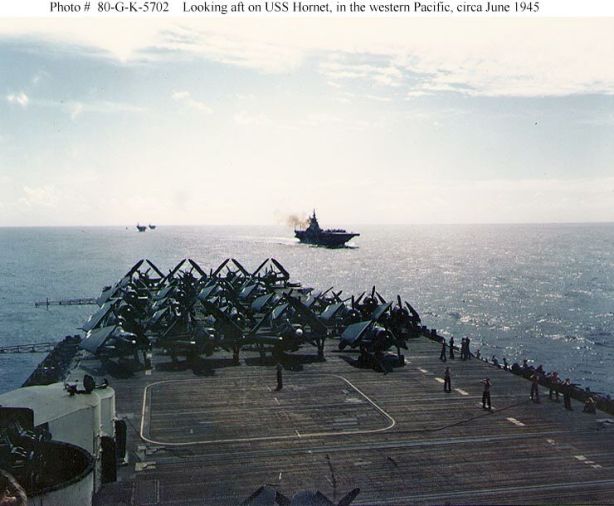
View looking aft from the ship’s island as she steams with other carriers during a western Pacific gunnery practice session, circa June 1945. Next ship astern is USS Bon Homme Richard (CV-31), firing her 5″/38 battery to starboard. Two small aircraft carriers (CVL) are beyond her. Note yellow flight deck markings on Hornet and TBM and SB2C aircraft parked aft. Official U.S. Navy Photograph, now in the collections of the National Archives (photo # 80-G-K-5702).
According to the USS Hornet (CV-12) ship’s log:
1 June 1945 – Planes were launched to support the advanced elements of ground forces on Okinawa.
4 June 1945 – Fueling was begun but discountinued when orders were received from ComThirdFleet. A typhoon, under observation, was moving north at a estimated speed of 12 knots.
TYPHOON CONNIE
(some accounts name it Typhoon Viper)
5 June 1945 – HORNET struck by typhoon with winds of 110-120 kts. and 100 foot seas. Twenty-four feet of flight deck at bow buckled. (Another account) The typhoon encompassed the Hornet and becuase of mountainous pyramidal seas of 50 to 60 feet from crest to trough the fight deck collapsed from the forward edge back to frame #4, a distance of 24 feet. These photographs speak louder than words
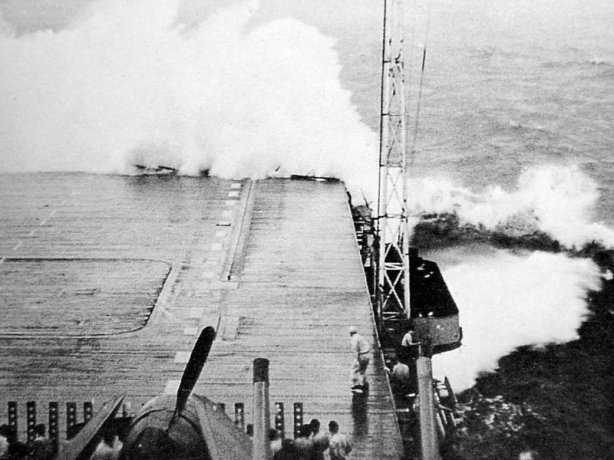
Photo taken from the bridge on the morning of June 5th, 1945 just as the first 24 feet of the flight deck get smashed to splinters by the typhoon. The forward antenna mast has left the ship!. National Archives.
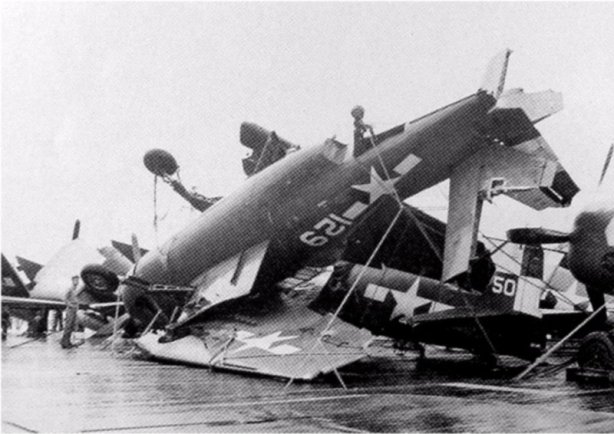
A VT-17 TBM-3E Avenger on top of a VF-17 F6F-5 Hellcat, June 6, 1945 the day after the typhoon.
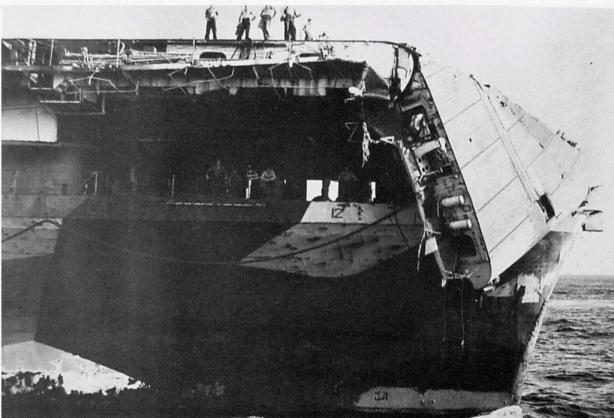
Shown here after weathering a typhoon on June 4–5, 1945. She continued on despite the damage and when it was too dangerous to launch over the bow, she backed into the wind until there was enough wind across the deck to safely launch planes. Compare these photos to those of Wasp (CV-18) and Bennington (CV-20). Tracy White, Researcher @ Large See additional photos and read “Flight deck structural failure and collapse during June 1945 Typhoon” at the Researcher @ Large website. Larger copy submitted by Steve Whitby.
6-7 June 1945 – Flights were launched, one plane spun in due to turbulance over the bow caused by teh overhanging portion of the flight deck.
7-10 June 1945 – Hornet’s planes participated in further strikes against Okinawa and other targets in the vicinity.
13 June 1945 – Entered and achored in San Pedro Bay between Leyte and Samar Island.
15 June 1945 – For a communication from Hornet’s Commanding Officer, A.K. Doyle to the Commander-in-Chief, U.S. Fleet, accompanied with more photographs, visit the following link. http://www.researcheratlarge.com/Ships/CV12/1945FlightDeckMemo.html
15 June 1945 – The Commanding Officer made the long anticipated announcement to the ship’s company that the Hornet would return to the United States for overhaul. Rear Admiral J.J. Clark lowered his flag in this vessel and Command of Task Group 38.1 was assumed by Rear Admiral T.L. Sprague in the Bennington (CV-20)
16 June 1945 – Embarked Air Group Thirty and Air Group Nine for transportation to the States.
19 June 1945 – Underway for Pearl Harbor
29 June 1945 – Moored at F-9-N Pearl Harbor
From the war diary found on the website, Fold3:
June 1945 – Strikes made on Okinawa and Kyushu.
The Hornet was operating in Task Unit 38.1.1 with CTG 38.1 (ComCarDiv 5) (Rear Admiral J.J. Clark) embarked. At 0530 on 1 June 1945, 6 VT were launched to land at Kadena Field on Okinawa from where they made 23 sorties during the day dropping supplies to advanced elements of ground forces. Ths operation was again repeated on 2 June 1945 but other flight operations were handicapped by bad weather.
The fourth of June brought the typhoon warning that hit the ship the next day. The typhoon caught the ship on 5 June 1945 and one of the mountainous wave collapsed the flight deck from the forward edge back to frame #4, a distance of 24 feet. The highest winds reached a velocity of 1210 knots with gusts up to 120 knots.
On 6 June 1945, 9 VF replacements were received from the ATTU (CVE-102) and six from the Bougainville (CVE-100). At 1414, a VF of the Shangri-la (CV-38) spun in on take-off due to turbulence over the bow caused by the overhanging portion of the damaged flight deck. The polit was rescued by the Dehaven (DD-737). Pending further investigation, it was considered unsafe to continue lauching over teh bow so the next flight, a search of 24 VF, was launched over the stern while the ship was backing down at 18.5 knots.
On 8 June 1945, a large strike was launched against Kanoya. Hornet’s planes dropped 67 fragmentation bombs on the target and took damage assessment photographs after the strike. (These must be the photographs above and at the link provided above).
On 9 -10 June 1945, strikes were made on Okino Daito Jima and Minami Daito Jima. Hornet anchored in San Pedro Bay between Leyte and Samar Island on 13 June 1945. From 15 June 1945 through 29 June 1945, see ships log above.
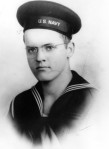


Reblogged this on IF I ONLY HAD A TIME MACHINE and commented:
From my other blog. Be sure to check out the video of the US Navy encounter with Typhoon Connie/Viper in June 1945.